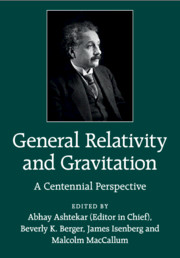Part Three - Gravity is Geometry, after all
Published online by Cambridge University Press: 05 June 2015
Summary
Introduction
Einstein's general relativity is a mathematically beautiful application of geometric ideas to gravitational physics. Motion is determined by geodesics in spacetime, tidal effects between physical bodies can be read directly from the curvature of that spacetime, and the curvature is closely tied to matter and its motion in spacetime. When proposed in 1915, general relativity was a completely new way to think about physical phenomena, based on the geometry of curved spacetimes that was largely unknown to physicists.
While the geometric nature of Einstein's theory is beautiful and conceptually simple, the fundamental working structure of the theory as a system of partial differential equations (PDEs) is much more complex. Einstein's equations are not easily categorized as wave- like or potential-like or heat-like, and they are pervasively nonlinear. Hence, despite the great interest in general relativity, mathematical progress in studying Einstein's equations (beyond the discovery of a small collection of explicit solutions with lots of symmetry) was quite slow for a number of years.
This changed significantly in the 1950s with the appearance of Yvonne Choquet- Bruhat's proof that the Einstein equations can be treated as a well-posed Cauchy problem [1]. The long-term effects of this work have been profound: Mathematically, it has led to the present status of Einstein's equations as one of the most interesting and important systems in PDE theory and in geometrical analysis. Physically, the well-posedness of the Cauchy problem for the Einstein equations has led directly to our present ability to numerically simulate (with remarkable accuracy) solutions of these equations which model a wide range of novel phenomena in the strong-field regime.
The Cauchy formulation of general relativity splits the problem of solving Einstein's equations, and studying the behavior of these solutions, into two equally important tasks: First, one finds an initial data set – a “snapshot” of the gravitational field and its rate of change – which satisfies the Einstein constraint equations, which are essentially four of the ten Einstein field equations.
- Type
- Chapter
- Information
- General Relativity and GravitationA Centennial Perspective, pp. 347 - 360Publisher: Cambridge University PressPrint publication year: 2015



